December 13, 2011
Children Visit Tohoku University's Ecollab. -- Learning Future Technologies through Environmental Study
Keywords: Newsletter
JFS Newsletter No.111 (November 2011)
"JFS's 'Get Inspired by Nature' Project" (No. 3)
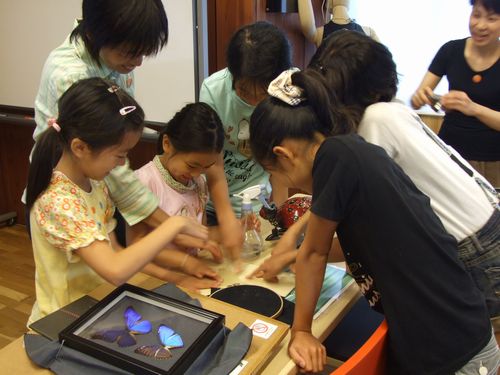
Copyright Japan for Sustainability
As part of JFS's "Get Inspired by Nature" Project, we have released series of articles featuring an interview with Professor Emile H. Ishida of Tohoku University's Graduate School of Environmental Studies and Eco-material Design & Process Engineering. This issue of JFS newsletter focuses on Ecollab., one of the main buildings at the Tohoku University research institute where Prof. Ishida works.
Graduate School of Environmental Studies, Tohoku University
http://www.kankyo.tohoku.ac.jp/en/index.html
Ecollab.
http://www.kankyo.tohoku.ac.jp/en/ecollab.html
On August 17, 2011, five children, ranging from an elementary school first grader to a junior high school second grader, represented JFS as "kid reporters," on a visit to Tohoku University's "Ecollab.," a laboratory belonging to the Graduate School of Environmental Studies at its campus in Sendai City, Miyagi Prefecture, in the northeastern part of Japan. They participated in a program called "exploration into the wonders of nature" designed by Prof. Ishida's study team for educating people of all ages and helping them learn about nature. Although the reporters were ordinary school children without any particular knowledge of the environment, they all enjoyed taking part in this program and learning about nature from a university professor.
Prof. Ishida's lecture started with an explanation of common environmental and global warming problems. Next, he spoke about what happened in Sendai and at the university during the Great East Japan Earthquake in March, and the subsequent troubles involving disconnected lifelines (water, gas and electricity) and traffic networks. The children learned that humans live in an ecological system of the earth, and that technologies have been developed using the dynamics of nature existing in our ecosystem. Unusual stories introduced by Prof. Ishida fascinated the children, such as the natural air-conditioning systems of termite mounds and the way elephants' ability to sense low frequency sound helped them escape the approaching threat of the Sumatran earthquake and tsunami in 2006.
Prof. Ishida's lecture started with an explanation of common environmental and global warming problems. Next, he spoke about what happened in Sendai and at the university during the Great East Japan Earthquake in March, and the subsequent troubles involving disconnected lifelines (water, gas and electricity) and traffic networks. The children learned that humans live in an ecological system of the earth, and that technologies have been developed using the dynamics of nature existing in our ecosystem. Unusual stories introduced by Prof. Ishida fascinated the children, such as the natural air-conditioning systems of termite mounds and the way elephants' ability to sense low frequency sound helped them escape the approaching threat of the Sumatran earthquake and tsunami in 2006.

Copyright Japan for Sustainability
"It was amazing how droplets of water sprayed on the special fabric became balls of water. I'd also like to know how the air conditioning wall functions after absorbing water."
"I found the waterproof fabric interesting because water took the shape of ball on it. I want to know more about storage cells. And I want to know the secret of fireflies."
"Experimenting with the cocklebur seeds was a lot of fun. It was interesting that the seeds are carried around by sticking to clothing or other fluffy things using its hooked spines which were visible with the magnifying glass."
"I found the breathing tile (or self-ventilating tile) and the structure of moth eyes very interesting. It is just a piece of tile, but it keeps the humidity of a room constant. We don't need to use an air conditioner if we have the tile. It was the first time I saw enlarged moth eyes. There are many ideas that can make our life better all around us. I think that is very impressive."
Ecollab is a wooden school building made from timbers harvested from the Field Science Center that is part of Tohoku University's Graduate School of Agricultural Science. Its construction plan was drawn up in the summer of 2007, and the building was completed in March 2010. The natural and warm texture of wood can be felt, and various experimental features were introduced into its construction to make it an eco-house and still function as one of the main buildings of the Graduate School of Environmental Studies. The name "Ecollab" comes from "eco", "collaboration", and "laboratory." The idea was to make this building a place to achieve an integration of interdisciplinary expertise from different academic areas into a new approach for tackling environmental challenges.
Ecollab. originally envisioned as a symbolic facility of the Graduate School of Environmental Studies, is also supposed to be a place to research and develop new technologies for solving environmental problems. While securing room for the flexible application of technologies being developed at the lab, the building is designed to have the warm, soft touch of wooden materials along with high levels of insulation and an airtight structure.
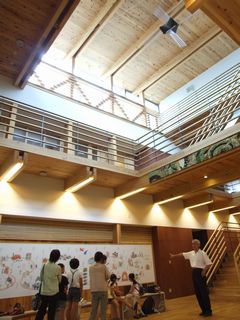
Copyright Japan for Sustainability
Ecollab.'s entrance hall has high ceiling. This space releases heat through an automatic ventilation window in summer, and a swinging air fan pushes the warm air near the ceiling downward in winter, helping to condition the indoor temperature. The building also has large windows for better light passage to decrease the need to use electric light during the daytime. A finishing coat was applied to its walls and ceiling to enhance the humidity conditioning function of the wood materials. These features help stabilize air and temperature conditions indoors. Also, a fan adapted from dragonfly wing structure is installed at the ceiling as a step towards developing an electricity generating system using rising air with a speed of 40 centimeters per second.
The construction of Ecollab. was based on an energy conservation technology development project for storing and utilizing electricity from small sources for eco-houses. It was selected by Japan's Ministry of the Environment in fiscal 2008 as one of the best projects for research and development of global warming prevention technologies, and was conducted as a three-year plan. The purpose of the project is to develop technologies and systems to capture and regenerate small amounts of unused household electricity and store it in a lithium battery. In general, electricity output from renewable energy sources is unstable and conventional battery life is short. Therefore, difficulties are perceived in using and establishing a national-scale infrastructure for renewable energy. However, the large-capacity lithium battery used in this project would make it possible to cover household electricity demand from renewable sources because it has a longer life and higher retention capacity than conventional batteries. In fact, this battery proved its potential right after the Great East Japan Earthquake in March 2011 by providing electricity to Ecollab. in the midst of blackouts due to the damage sustained by the electricity distribution infrastructure.
Ecollab. functions as a showroom that presents a new lifestyle with devices that apply the latest technology, for example, those that utilize direct current (DC) electricity to avoid energy loss from conversion into alternating current (AC), and storing small amounts of generated electricity. In other words, the lifestyle here proposed is based on the idea of generating and consuming electricity locally, in contrast to our conventional lifestyles that depend on large-scale distribution & consumption of electricity generated from fossil fuels. For example, decentralized lighting systems using light-emitting diodes (LED) can activate lighting anywhere in a room and control brightness as much as needed. A "DC Table" provides electricity outlets at the center of the room, which is the center of daily life activities, rather than from fixed wall outlets. These devices are appropriate for a new, user-centered lifestyle.
From the Ecollab. viewpoint, in realizing a lower carbon lifestyle without reducing the quality of life, it is essential for people to smoothly integrate into their everyday life the practices of utilizing renewable energy, reducing energy loss, and capturing & storing small amounts of energy. Ecollab.'s DC Life Space features the latest technologies as a model to demonstrate the feasibility of such practices, for example its energy control system with a high-technology direct DC feed and efficient use of renewable energy that reduces electricity loss caused by power conversion from DC to AC.
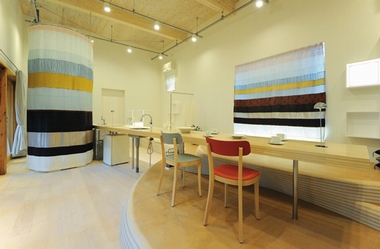
Copyright Tohoku University
A solar air conditioning system is also used under the floor of Ecollab., which is cooled by a dehumidifier and heat pump in summer and heated by solar heat in winter. Through adopting multiple natural systems like this, it may be possible to build a disaster-proof eco-house with low energy use that can deal with sudden power outages.
On this Ecollab. tour, our kid reporters were delighted with their own discoveries and seemed to be fascinated by new questions and curiosity. We asked them to give us their impressions of the tour after they returned home. Their feedback includes many ideas how to make good use of technologies learned from nature.
"I think water-repellent fabric is good material for mobile phones and cameras that are easily damaged by water. They wouldn't get wet if this material was used, because water drops roll off its surface."
"It is important to burn oil as little as possible to curb global warming. If a non-electric air conditioner is developed, it will be good for the Earth and save energy so we won't need to burn oil."
"I wish a new telescope could be developed using the mechanism of birds' eyes. I learned that birds have good sight, and so I came up with this idea for telescopes and binoculars."
"The stain-free mechanism of snail shells' surface can be applied to kitchen stuff to keep it clean without using any detergent. We can avoid discharging polluted water and reduce water use, and further, we can save energy and water at water treatment plants."
"I was amazed to learn that the nature around me has such wonderful systems. I also realized that there are a lot of things I don't know about the Earth and nature. From now on, instead of just following others' energy-saving efforts, I want to observe natural systems more carefully myself and discover something we can take into our daily life."
"Wild creatures have been living on the Earth much longer than humans. So, we should not care only about human-beings. I hope that we can all live in harmony."
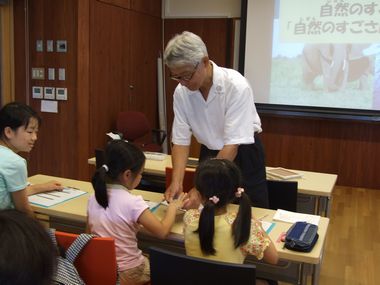
Copyright Japan for Sustainability
After experiencing energy and supply shortages due to the earthquake in March 2011, Tohoku University's Graduate School of Environmental Studies started publishing a series of booklets entitled "Look ahead to life in 2030. --Tips for leading a spiritually affluent life with less energy and limited resources." These booklets target the general public and contain many illustrations and concrete numerical figures so that children and young people can also enjoy reading them.
Ecollab. continues to suggest new lifestyles for the next generation, while providing information to children on the wonders of natural systems.
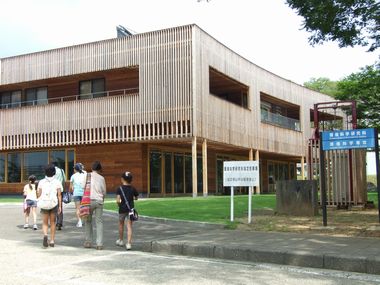
Copyright Japan for Sustainability
Written by Nobuko Saigusa
This project is supported by Hitachi Environment Foundation
See also: JFS "Get Inspired by Nature" Project
Related
"JFS Newsletter"
- 'Good Companies in Japan' (Article No.4): 'Eightfold Satisfaction' Management for Everyone's Happiness
- "Nai-Mono-Wa-Nai": Ama Town's Concept of Sufficiency and Message to the World
- 'Yumekaze' Wind Turbine Project Connects Metro Consumers and Regional Producers: Seikatsu Club Consumers' Co-operative
- Shaping Japan's Energy toward 2050 Participating in the Round Table for Studying Energy Situations
- 'Good Companies in Japan' (Article No.3): Seeking Ways to Develop Societal Contribution along with Core Businesses


